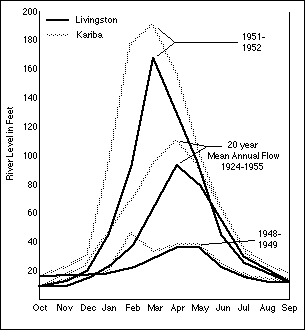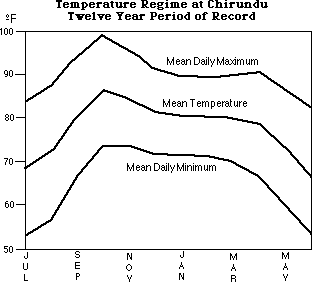 Annual
River Level Variation
Annual
River Level VariationThe environment inhabited by the Valley Tonga is one of extremes. Extremes of heat and cold, extremes of rainfall or the lack, and extremes exhibited by the flow of the river. There are three distinct seasons in the region - the rainy season from November to March, the cold season from April to August, and the hot season from August to November. The seasons in turn are marked by monthly and annual cycles of rainfall and changes in the flow of the Zambezi. The following provides you with some indication of the range of variation in river flow and temperature from year to year and during the year. Study these carefully, because some of this information will guide your planting and harvesting decisions during the simulation.
Rainfall and Annual River Level Change
As you can see below, the river level begins to rise in December, and continues rising until March or April. You will also note the dramatic variability in river flow from year to year. If the flood level is not high enough, the Tonga's Floodplain fields do not receive the necessary load of rejuvenating silt, and their productivity is diminished. If the river floods too much, the Floodplain and River Bank fields are exposed too late for planting, or may be too wet to grow the necessary crops.
 Annual
River Level Variation
Annual
River Level Variation
Annual Temperature Variation
Note the annual cycle of temperature change. The highest temperatures occur from August to October. There is a gradual decline during the rainy season, and then a significant drop in temperatures from April to July - the cold season. The hot season is the period of greatest strain on resources because water and food supplies tend to be in shortest supply then. Survival during these months depends on adequate storage.
 Annual
Temperature Cycle
Annual
Temperature Cycle
|
|
|
|